Losing an arm or a hand can feel overwhelming, but modern prosthetic technology has made it possible for individuals to regain independence, confidence, and functionality. Whether you were born without a limb or lost it due to an accident or illness, upper limb prosthetics can help restore movement and control.
This guide will walk you through everything you need to know about upper limb prosthetics—from the different types available to the fitment process and the latest innovations. If you’re considering a prosthetic solution, this article will help you make an informed decision, ensuring you find the right fit for your needs and lifestyle.
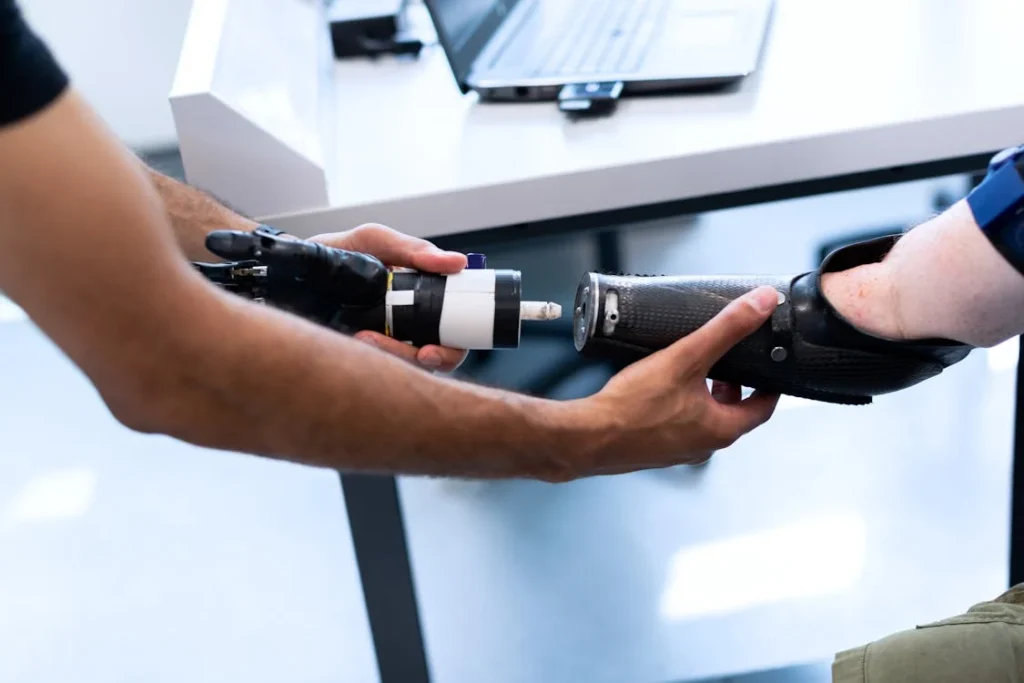
Types of Upper Limb Prosthetics
Choosing the right upper limb prosthetic depends on several factors, including the level of limb loss, personal preferences, and daily activities.
There are three main types of upper limb prosthetics: cosmetic, body-powered, and myoelectric.
Each type serves a different purpose and offers a unique balance between function and appearance.
Cosmetic Prosthetics
Cosmetic prosthetics, also known as passive prosthetics, are designed primarily for appearance rather than function.
They are lightweight and shaped to resemble a natural hand or arm, often with skin-tone matching to enhance realism.
These prosthetics do not have moving parts, but they help restore body symmetry, boost confidence, and provide basic support when carrying light objects or stabilizing items.
While cosmetic prosthetics do not offer mechanical movement, they are an excellent option for individuals who prioritize a natural look or do not require extensive hand functionality for daily tasks.
Many people choose them for social confidence, as they help reduce the visibility of limb loss without requiring complex technology.
Body-Powered Prosthetics
Body-powered prosthetics use a system of cables and harnesses to control movement.
These prosthetics rely on the wearer’s upper body strength to operate the artificial hand, wrist, or elbow.
Typically, a harness is worn around the shoulders, and a cable connects the harness to the prosthetic limb.
When the user moves their body in a certain way, the cable tightens, causing the hand or hook to open or close.
One of the biggest advantages of body-powered prosthetics is their durability.
They are designed for people who need a sturdy and reliable prosthetic for work or daily activities.
Since they do not rely on batteries or electronics, they are easy to maintain and can function in various environments, including outdoors and in wet or dusty conditions.
However, body-powered prosthetics require physical effort to operate, which can be tiring over long periods.
Some users also find the harness system uncomfortable, especially during hot weather.
Despite these challenges, many people prefer body-powered prosthetics for their practicality and cost-effectiveness.
Myoelectric Prosthetics
Myoelectric prosthetics represent the most advanced option in upper limb prosthetics.
These devices use electrical signals from the user’s muscles to control movement.
Sensors placed inside the prosthetic detect muscle activity and translate it into commands, allowing the hand or fingers to move naturally.
This technology provides a higher level of function, enabling users to perform tasks that require precision, such as holding a glass, typing, or even using a phone.
One of the biggest advantages of myoelectric prosthetics is their ability to offer more natural movement.
Users can control their prosthetic hand without relying on external cables or harnesses, making the device feel more like an extension of their body.
Modern myoelectric hands, like Grippy™ by Robobionics, also feature multiple grip patterns and enhanced dexterity, allowing users to complete daily activities with greater ease.
However, myoelectric prosthetics require battery power and regular maintenance.
They can also be more expensive than other types, making cost a consideration for many users.
Despite these factors, they are an excellent choice for individuals who want advanced functionality and a more intuitive prosthetic experience.
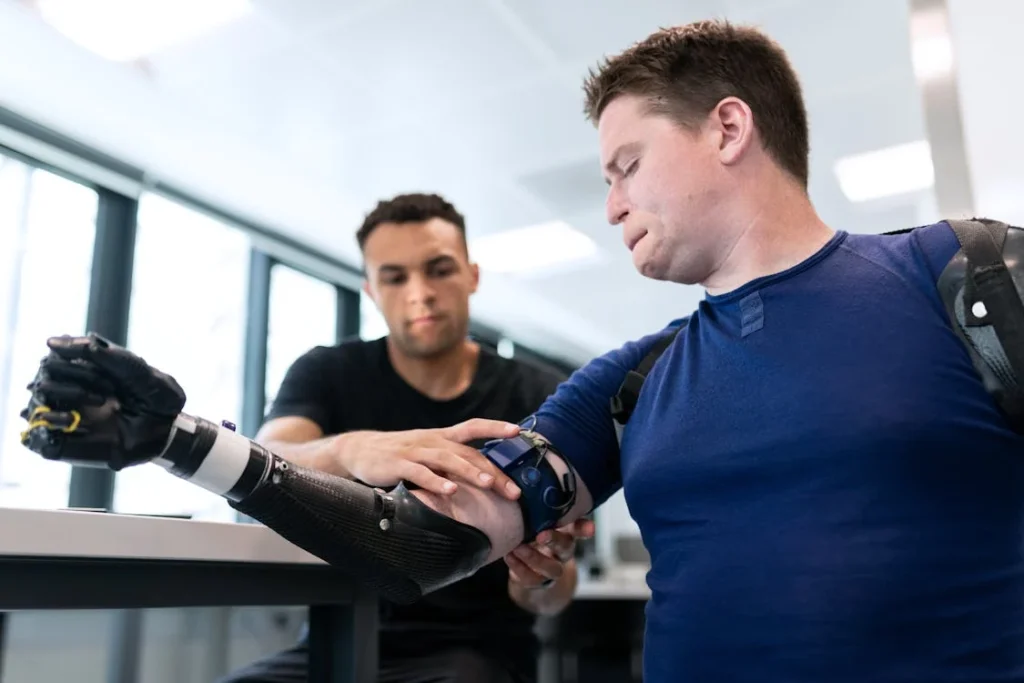
The Fitment Process: Finding the Right Prosthetic for You
Getting an upper limb prosthetic is not just about choosing the type—it’s about finding the right fit for your body, lifestyle, and needs.
The fitment process is crucial because a well-fitted prosthetic ensures comfort, functionality, and long-term usability.
This process involves several stages, from an initial assessment to the final adjustments, ensuring that your new prosthetic feels like a natural extension of your body.
Initial Consultation and Assessment
The journey begins with a consultation with a prosthetist, a specialist who designs and fits artificial limbs.
During this session, the prosthetist will evaluate the level of limb loss, muscle strength, and overall health.
They will also discuss your daily activities, work requirements, and personal preferences to understand what type of prosthetic will best suit you.
One of the key factors in this assessment is determining whether you have enough muscle control for a myoelectric prosthetic or if a body-powered option would be more suitable.
If you are considering a myoelectric prosthetic, the prosthetist will test your muscle signals using small sensors to see if they can effectively control an electronic hand.
Taking Measurements and Making a Mold
Once the right type of prosthetic is chosen, the next step is to take precise measurements of your residual limb.
In many cases, a plaster or digital scan is used to create an exact mold of your limb.
This mold ensures that the prosthetic socket—the part that connects your limb to the artificial arm—fits perfectly and comfortably.
The socket is one of the most important parts of the prosthetic. If it is too loose, the prosthetic may slip or feel unstable.
If it is too tight, it can cause discomfort and skin irritation. A well-fitted socket allows for better control, reduces pressure points, and makes the prosthetic feel more natural.
Trial and Adjustment Phase
Before receiving the final prosthetic, most users go through a trial phase. During this period, a temporary or test socket is used to evaluate the fit and function.
This is an essential step because it allows adjustments to be made before the final prosthetic is built.
During the trial, the prosthetist will guide you through basic movements and tasks to ensure that the prosthetic fits well and does not cause discomfort.
If any issues arise, such as pressure points or limited movement, modifications are made to improve the fit.
Final Fitting and Training
Once the prosthetic is perfected, the final fitting takes place. At this stage, the permanent prosthetic is attached, and you begin learning how to use it effectively.
Training is an essential part of this process, as it helps you adapt to your new limb and use it with confidence.
If you have a myoelectric prosthetic, you will practice controlling it with your muscle signals, learning how to perform different movements smoothly.
If you are using a body-powered prosthetic, training will focus on harness control and efficient movement patterns.
Rehabilitation and Adaptation
Adapting to an upper limb prosthetic takes time. Many users experience an adjustment period where their body learns to work with the new device.
To make this process smoother, Robobionics offers home-based gamified rehabilitation, a fun and engaging way to improve coordination and control.
By incorporating interactive exercises, users can build muscle memory and confidence while adjusting to their prosthetic.
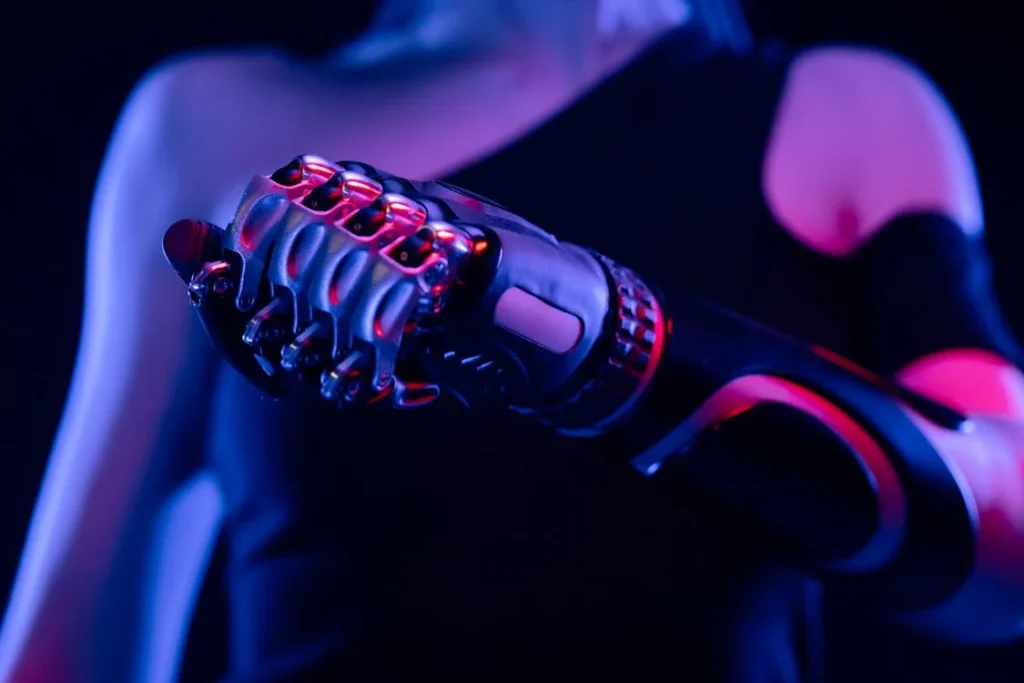
Innovations in Upper Limb Prosthetics
The field of prosthetics has seen remarkable advancements in recent years. From improved materials to cutting-edge technology, modern prosthetics are now more functional, comfortable, and intuitive than ever before.
These innovations are changing lives by making artificial limbs feel more natural and responsive, helping users regain not just mobility but also confidence and independence.
3D Printing: Affordable and Customizable Prosthetics
One of the biggest breakthroughs in prosthetic design is the use of 3D printing.
Traditional prosthetics can be expensive and take weeks or even months to manufacture.
With 3D printing, customized prosthetics can be created quickly and at a lower cost.
At Robobionics, we use advanced 3D printing technology to produce lightweight, ergonomic prosthetic hands like Grippy™.
This approach allows for highly personalized designs that fit comfortably and match the user’s specific needs.
Additionally, 3D printing makes it easier to replace or upgrade parts, reducing maintenance costs and ensuring users always have access to the latest advancements.
Myoelectric Advancements: Smarter, More Intuitive Control
Myoelectric prosthetics have been around for a while, but recent developments have made them smarter and more responsive.
Today’s myoelectric hands use advanced sensors to detect even the slightest muscle movements, allowing for more precise control.
Artificial intelligence (AI) is also playing a role in improving these devices.
AI-powered prosthetics can learn from the user’s movement patterns, making control more intuitive over time.
Some advanced hands even feature multiple grip modes, enabling users to switch between different types of grasps depending on the task.
Sensory Feedback: Bringing Back the Sense of Touch
A major challenge with prosthetics has always been the lack of sensation. When a person loses a limb, they also lose their ability to feel textures, pressure, and temperature.
However, new developments in sensory feedback technology are helping bridge this gap.
Some prosthetics now come with built-in sensors that provide real-time feedback to the user.
These sensors send signals to the nervous system, allowing the wearer to “feel” objects through vibrations or electrical impulses.
This breakthrough has the potential to transform the way people interact with their prosthetic limbs, making tasks like holding a fragile item or adjusting grip strength much easier.
Gamified Rehabilitation: Making Adaptation Easier and More Engaging
Learning to use a prosthetic can be challenging, especially for first-time users.
To make this process more engaging, Robobionics has introduced gamified rehabilitation.
This method uses interactive games and exercises to help users develop control and coordination with their new limb.
By turning rehabilitation into a fun and rewarding experience, users are more likely to practice regularly and build the skills needed to use their prosthetic effectively.
This approach also helps reduce frustration and makes the learning process more enjoyable.
The Future of Upper Limb Prosthetics
The future of prosthetic technology is incredibly promising.
Researchers are working on brain-controlled prosthetics that can be operated through direct neural connections, eliminating the need for muscle signals.
Advances in bionic limbs, soft robotics, and even regenerative medicine could further enhance functionality and comfort.
At Robobionics, we are committed to staying at the forefront of these innovations.
Our goal is to provide users with the most advanced, accessible, and affordable prosthetic solutions available.
If you’re interested in exploring our latest prosthetic designs, book a free demo of Grippy™ today and experience the future of bionic hands for yourself.
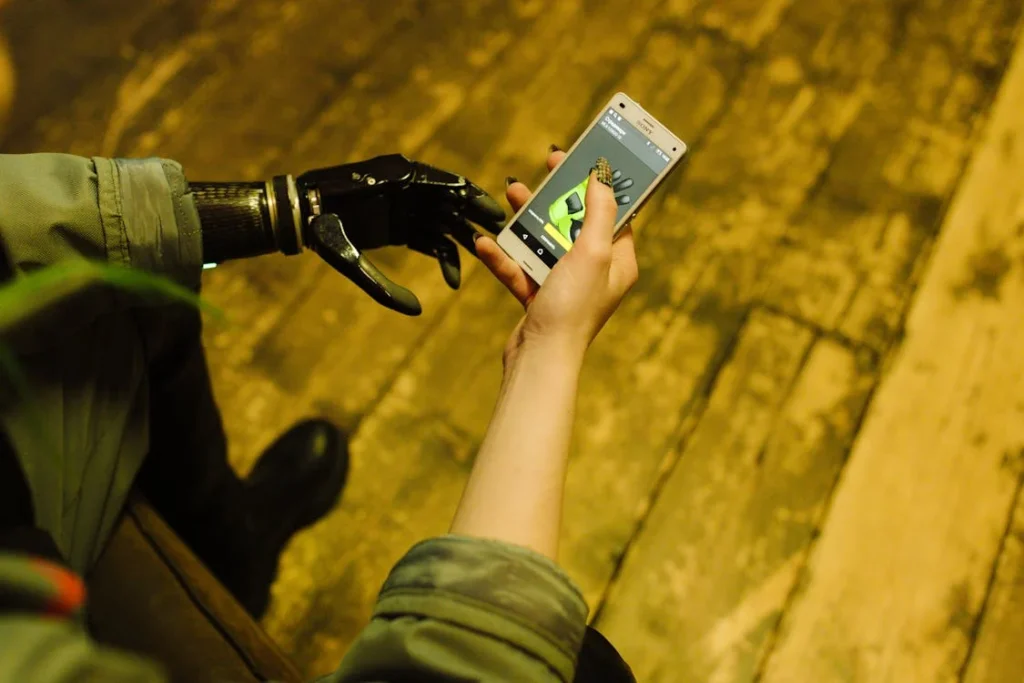
Choosing the Right Upper Limb Prosthetic for Your Lifestyle
Selecting the right prosthetic is a deeply personal decision that depends on your daily activities, profession, personal goals, and comfort level.
A prosthetic should not just restore function; it should integrate seamlessly into your life, helping you regain independence and confidence.
Understanding how different prosthetics align with your lifestyle can make a huge difference in ensuring long-term satisfaction and ease of use.
Work and Professional Needs
Your job plays a big role in determining which prosthetic is best for you.
If you work in an office setting and need to type, write, or handle small objects, a myoelectric hand with multiple grip patterns may be the ideal choice.
The ability to switch between different grasping modes allows for more precise control, making tasks like using a keyboard or picking up documents much easier.
For those in physically demanding jobs, such as construction, agriculture, or mechanical work, durability is key.
Body-powered prosthetics, which use cables and harnesses, offer a sturdy and low-maintenance option.
They are designed to withstand rough environments and can be used in conditions where electronic prosthetics might not function as effectively, such as in wet or dusty areas.
Sports and Active Lifestyles
If you lead an active lifestyle or participate in sports, your prosthetic should support movement and endurance.
Many users who engage in running, cycling, swimming, or weightlifting opt for specialized prosthetic attachments designed for sports activities.
These attachments enhance performance and provide better control during physical activities.
Myoelectric hands are also improving in their ability to support active lifestyles, with stronger grip forces and longer battery life.
If you love outdoor activities, it’s essential to choose a prosthetic that is both weather-resistant and easy to maintain.
Personal Independence and Daily Activities
Everyday tasks, such as cooking, dressing, driving, or caring for children, require a prosthetic that feels natural and responsive.
Myoelectric prosthetics provide the closest experience to natural hand movement, helping users perform delicate actions with ease.
Features like proportional control, which allows for varied grip strength, make it possible to hold fragile objects like eggs or glasses without breaking them.
However, some users prefer the simplicity of a body-powered prosthetic for daily tasks.
These prosthetics do not require charging and provide reliable mechanical control.
The decision ultimately comes down to personal preference and the level of fine motor skills needed for your routine.
Comfort and Long-Term Wear
Comfort is one of the most critical factors when selecting a prosthetic.
A poorly fitted prosthetic can cause discomfort, skin irritation, and even long-term strain on your body.
The socket, which connects the prosthetic to your residual limb, must fit snugly without causing pressure points.
At Robobionics, we ensure a precise fit by using advanced scanning and molding techniques to create custom sockets that enhance comfort and stability.
Our lightweight designs, like those in Grippy™, reduce fatigue and improve long-term wearability.
Additionally, our gamified rehabilitation programs help users adjust more quickly, ensuring they get the most out of their prosthetic.
Making the Right Decision
Choosing a prosthetic is about finding the right balance between function, comfort, and personal goals.
Consulting with a prosthetist and trying different options through demo sessions can help you make an informed decision.
At Robobionics, we offer free prosthetic trials to ensure you find the best fit for your lifestyle.
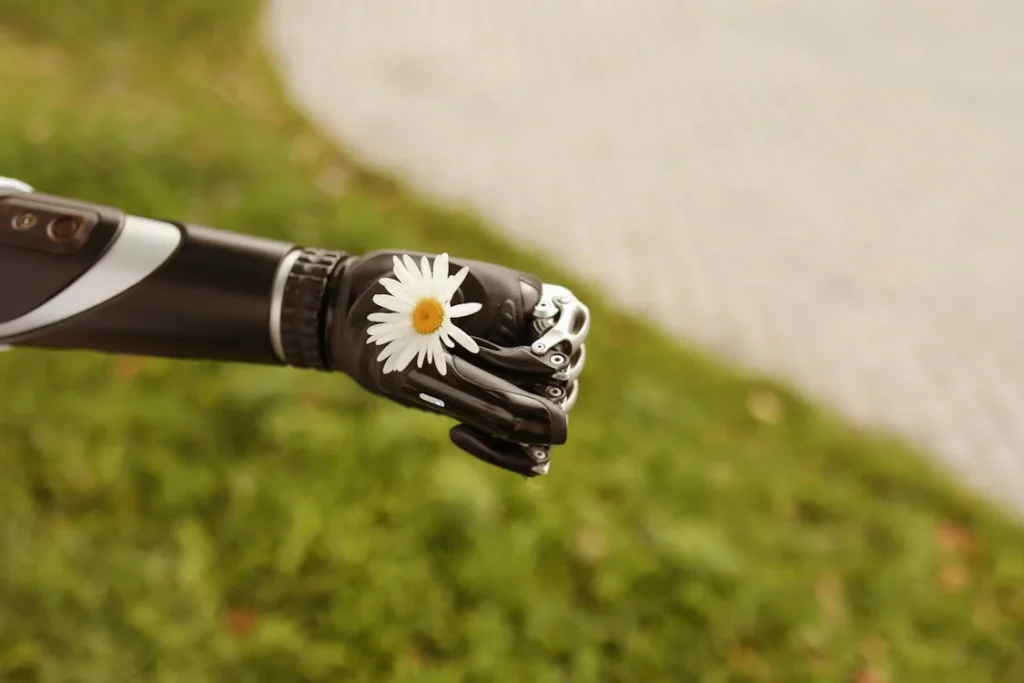
The Emotional and Psychological Journey of Using a Prosthetic
Getting an upper limb prosthetic is not just a physical adjustment—it’s an emotional journey as well.
Losing a limb can be a life-altering experience, and while prosthetics can restore functionality, the mental and emotional adaptation takes time.
Many users go through a range of feelings, from excitement and hope to frustration and doubt.
Understanding this journey and finding the right support can make a world of difference in how smoothly you adapt to your new limb.
Accepting Change and Building Confidence
One of the biggest challenges for new prosthetic users is accepting their new reality. It’s normal to feel self-conscious or unsure about how others will perceive you.
Some people hesitate to wear their prosthetic in public, while others worry about whether they will ever regain their independence.
These feelings are completely natural, and it’s important to give yourself time to adjust.
Confidence comes with practice. The more you use your prosthetic, the more natural it will feel.
Engaging in activities you enjoy, whether it’s cooking, writing, or even playing an instrument, can help build familiarity and ease.
Robobionics’ gamified rehabilitation programs also make this transition easier by turning practice into an engaging and enjoyable experience.
Overcoming Frustration and Learning Patience
Adjusting to a prosthetic is not always easy. Some days, things will feel smooth, and on others, even simple tasks may seem frustrating.
Learning to use a prosthetic hand, especially a myoelectric one, takes time. Muscle signals need to be trained, grip patterns need to be practiced, and coordination must be developed.
Patience is key during this stage. Many users find it helpful to set small, achievable goals. For example, mastering picking up a spoon before moving on to more complex tasks like buttoning a shirt.
Celebrating these small wins helps build confidence and keeps you motivated.
The Role of Family and Social Support
Having a strong support system can make a big difference in your prosthetic journey.
Friends and family play an important role in helping you adjust, whether it’s through encouragement, physical assistance, or simply being there to listen.
Many users also find comfort in connecting with others who have gone through similar experiences.
Support groups, online communities, and rehabilitation centers offer spaces where you can share challenges, tips, and success stories with people who truly understand your journey.
Changing Perceptions: A New Perspective on Disability
For many, using a prosthetic is not just about regaining function but also about reshaping their identity.
Society often has preconceived notions about disability, but modern prosthetics are proving that limb loss does not mean losing independence or ability.
With advancements in bionics, many users find themselves performing tasks as efficiently—if not better—than before.
Many prosthetic users become advocates for change, inspiring others with their resilience.
By embracing technology and pushing boundaries, they redefine what is possible, proving that prosthetics are not just replacements for lost limbs but tools that enhance life.
Moving Forward with Confidence
Adapting to a prosthetic is a journey, but it’s one that leads to empowerment. Every step, from learning how to use it to gaining confidence in public, brings you closer to full independence.
At Robobionics, we are here to support you every step of the way. Whether it’s through personalized fitment, advanced bionic solutions like Grippy™, or our rehabilitation programs, we are committed to helping you regain not just movement, but confidence in every aspect of life.
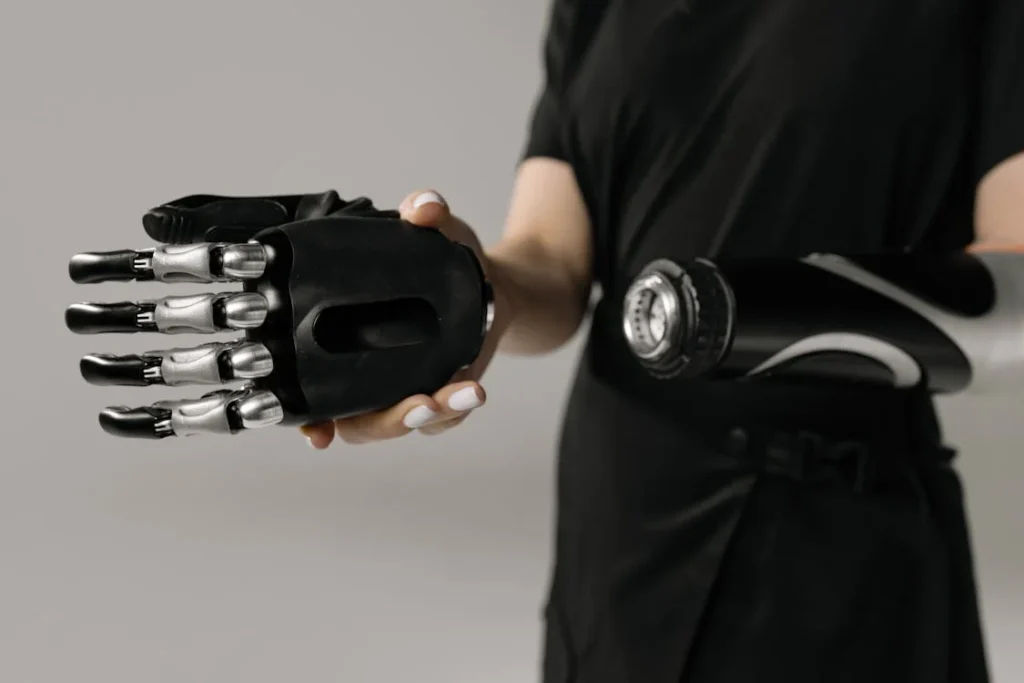
The Role of Technology in Personalizing Prosthetics
Advancements in technology have not only improved the functionality of upper limb prosthetics but also made them more personalized to fit the unique needs of each user.
No two individuals experience limb loss in the same way, which is why customization is becoming a key focus in modern prosthetic development.
From AI-driven adaptability to user-specific designs, technology is reshaping how prosthetics feel, function, and integrate into daily life.
Artificial Intelligence and Machine Learning in Prosthetics
One of the most exciting developments in prosthetic technology is the integration of artificial intelligence (AI) and machine learning.
Traditional prosthetics rely on preset movements, meaning users must learn to control their artificial limb in a specific way.
However, AI-powered prosthetics can now learn from the user’s natural movements and adapt over time.
For example, some advanced myoelectric hands can analyze muscle signals and predict what movement the user intends to make.
This reduces the learning curve and makes using the prosthetic feel more natural.
AI also allows for real-time adjustments, meaning the prosthetic can fine-tune itself based on how the user interacts with different objects, ensuring a smoother experience.
3D Scanning and Digital Fitment
Getting a well-fitted prosthetic is one of the most crucial factors in comfort and usability.
In the past, creating a custom socket required multiple fittings and adjustments, which could be time-consuming and sometimes uncomfortable.
Today, digital scanning and 3D modeling allow for precise measurements to be taken in minutes.
At Robobionics, we use state-of-the-art scanning technology to design prosthetics that fit perfectly to the user’s residual limb.
This ensures better stability, reduces discomfort, and minimizes the chances of skin irritation.
The accuracy of digital fitment also speeds up the process, allowing users to receive their prosthetics faster without compromising on comfort.
Smart Prosthetics with Connectivity Features
With the rise of smart technology, prosthetic limbs are now being designed with connectivity features that enhance user experience.
Some advanced prosthetic hands can sync with a smartphone app, allowing users to customize grip patterns, track performance, and receive real-time feedback on their usage.
This level of control gives users the ability to fine-tune their prosthetic to match their lifestyle.
Whether adjusting grip sensitivity for different tasks or updating software for improved performance, smart prosthetics offer a more personalized and intuitive experience.
Biometric Sensors for Better Control
Another breakthrough in prosthetic technology is the use of biometric sensors.
These sensors can detect muscle activity, skin temperature, and even the slightest nerve impulses, providing greater precision in movement.
Some prosthetics are now being developed with sensors that can relay pressure and texture information back to the user, giving them a more natural sense of touch.
Although still in the early stages, this technology has the potential to completely change how prosthetic users interact with the world.
Imagine being able to feel the difference between a rough and smooth surface or adjusting your grip automatically when holding a delicate object—all thanks to real-time sensory feedback.
The Future of Personalized Prosthetics
The future of prosthetics is moving towards complete personalization.
AI-driven adaptability, digital scanning, and smart connectivity are all shaping a new era where prosthetic limbs are not just replacements but enhancements.
The goal is to create prosthetics that feel like a true extension of the body, providing users with both function and comfort.
At Robobionics, we are dedicated to pushing the boundaries of what’s possible. By integrating the latest technological advancements into our designs, we ensure that every prosthetic we create is as unique as the individual wearing it.
If you’re interested in experiencing a truly personalized prosthetic solution, contact us today and explore how our innovations can transform your daily life.
Conclusion
Upper limb prosthetics have come a long way, offering not just function but also a renewed sense of independence and confidence. From cosmetic limbs to highly advanced myoelectric hands, today’s prosthetics are designed to meet the diverse needs of users. The integration of AI, 3D printing, and smart technology has made prosthetics more personalized, intuitive, and accessible than ever before.
The journey to finding the right prosthetic is deeply personal. It involves careful consideration of comfort, functionality, and lifestyle needs. The right fit can transform daily life, making tasks easier and movement more natural. Rehabilitation and emotional adaptation are equally important, helping users fully embrace their new limb.
At Robobionics, we are committed to providing cutting-edge prosthetic solutions that prioritize both performance and user experience. Whether you’re looking for a first-time prosthetic or an upgrade, we’re here to guide you every step of the way. Book a free demo of Grippy™ today and take the first step toward a future of limitless possibilities.



